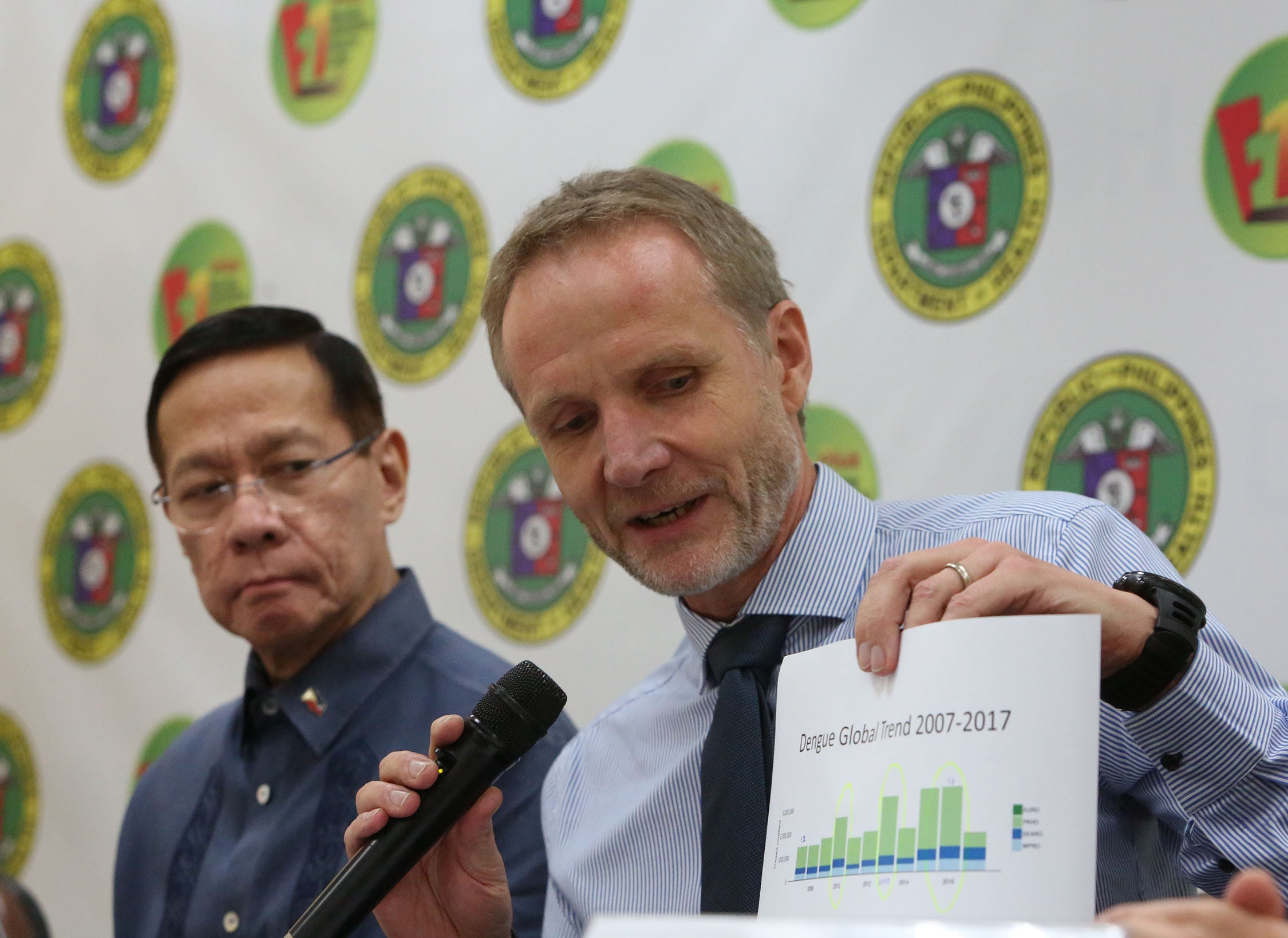
DENGUE BRIEFING Health Secretary Francisco Duque III and Gundo Weiler, country representative of the World Health Organization, give an update of the dengue incidence in the Philippines and globally on Monday. —MARIANNE BERMUDEZ
MANILA, Philippines — The Department of Health (DOH) declared a national dengue alert on Monday after the viral illness claimed the lives of at least 450 people, including infants and a centenarian, in the first six months of the year amid a surge in reported cases of the mosquito-borne disease.
“This is the first time we’re declaring a national alert because the objective is clear: We want to raise awareness among the public and, more importantly, in communities where signs of early dengue increases are evident,” Health Secretary Francisco Duque III said at a press briefing.
From Jan. 1 to June 29, a total of 106,630 dengue cases were reported nationwide, including 456 deaths, according to records of the DOH.
“This is 85 percent higher compared to the same period last year, which is 57,564,” Duque said.
But he assured the public that there was no national epidemic.
“It’s localized,” he said.
Epidemic in regions
Among regions that have exceeded the epidemic threshold are Mimaropa (Mindoro, Marinduque, Romblon and Palawan), Western Visayas, Central Visayas and Northern Mindanao.
Duque said clustering of cases must be identified by the DOH regional office as a basis for declaring a localized epidemic at the barangay level.
The following regions are being monitored after having exceeded the alert threshold: Ilocos, Cagayan Valley, Calabarzon (Cavite, Laguna, Batangas, Rizal and Quezon), Bicol, Eastern Visayas, Zamboanga Peninsula, Davao, Bangsamoro Autonomous Region in Muslim Mindanao and Cordillera Administrative Region.
Duque also announced on Monday the activation of the code blue alert for the National Disaster Risk Reduction and Management Council health cluster. A code blue alert means half of all hospital personnel will report for duty.
Western Visayas has the biggest number of reported dengue cases so far this year with 13,164, followed by Calabarzon (11,474 cases), Central Visayas (9,199 cases), Soccsksargen (9,107 cases) and Northern Mindanao (8,739 cases).
The biggest number of cases over the past seven years was recorded in 2016 at 220,518. A total 1,092 died that year, also the biggest during the period, DOH data showed.
4 serotypes
The dengue virus is spread through the bite of an infected female Aedes aegypti, a small and dark mosquito with white lyre markings.
There are four serotypes of dengue (dengue 1 to 4). First infection with one of the four serotypes is usually asymptomatic, or nonsevere, but second infection with one of other serotypes may cause severe dengue.
Duque said dengue cases had been observed to peak every three to four years. The last peak occurred in 2016.
Given this pattern, the DOH expects an increase in dengue cases this year.
“The observed dengue spikes every three to four years is really a phenomenon. No science is able to explain except for circumstantial evidence of climate change and other factors,” Duque said.
He said effective surveillance could also help reduce cases and deaths if areas with clustering of cases were identified early.
Symptoms
Signs and symptoms of the disease are severe headache, pain behind the eyes, severe joint and muscle pain, fatigue, nausea, vomiting and skin rashes.
Duque said it was important to seek medical attention as soon as dengue symptoms appeared, such as fever running for more than two days, severe joint and muscle pain, fatigue, nausea, skin rashes and bleeding.
Early detection and proper case management could prevent deaths, he said.
The most effective way to prevent dengue, according to the health secretary, is still the 4S strategy:
- Search and destroy mosquito breeding places
- [Take] self-protective measures like wearing clothes with long sleeves and using insect repellent
- Seek medical advice on the first signs and symptoms of the disease
- Say yes to fogging if there is an impending outbreak.
In April 2016, the DOH launched an immunization program, providing free Dengvaxia vaccines to selected Grade 4 public school pupils in three regions.
More than 700,000 public school fourth graders received the first of three doses of the vaccine.
On Dec. 1, 2017, the health department halted the vaccination program, three days after the French pharmaceutical company Sanofi announced the results of new analysis that found Dengvaxia worsened symptoms in vaccinated people who had no previous exposure to the dengue virus.
In January 2018, Duque announced that most of the 14 children who died after being immunized with Dengvaxia were found to have died of dengue shock syndrome.
But Duque could not say if the vaccine directly caused the children’s deaths.
Screened classrooms
Amid the rising number of dengue cases, Senate President Pro Tempore Ralph Recto proposed that all public classrooms that would be built should have screened windows and doors.
“During school days, one in four Filipinos are in public schools,” Recto said, adding that this amounts to some 27 million students.
“If Filipinos congregate there, then we should make sure that mosquitos don’t go to school with them. Aedes aegypti should not be enrolled, or if they’re there, they should be expelled,” he added.
He noted that schoolchildren formed the largest group of people who contracted dengue.
But if the new classrooms would be screened and old ones would get the same feature, it would help stave off the disease, he said.
Recto said a similar plan was proposed in 2015, to cover some 20,000 classrooms. The Department of Education maintains 757,006 rooms nationwide.
Recto said a budget could be set aside to buy screens for existing classrooms, and their installation could be handled by school stakeholders, “bayanihan style.” —With reports from Leila B. Salaverria and Inquirer Research